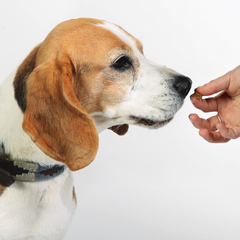Is Your Dog Ready for an MOT?
In this post, we will cover how you can look for signs that your dog may be ready for a health check-up, and ways that you can change your dog’s routine as they develop.

Generally, dogs should have a complete health check-up by a professional vet at least once a year. This will ensure that your dog stays healthy and happy and gives you the opportunity to discuss any concerns with your vet. Having regular check-ups will ensure that you can spot any abnormalities early which will allow you to get illnesses treated quickly.
Signs of a healthy dog include;
- Fresh breath - indicating a healthy mouth
- A shiny and clean coat
- Consistently lean weight
- Regular bladder and bowel movements
- Alert and engaged
- Clean and odour-free ears
The reason it is so important to get routine maintenance check-ups on your dog is because dogs age more rapidly than humans, which means their health needs more closely monitoring than ours.

What does a dog health check-up include?
When you take your dog to the vet for their health check-up, your vet will ask if you’ve noticed any changes in your pet’s behaviour. Examples in changes of behaviour could include sleeping less/more, eating or drinking less/more, being more or less playful, or having more aggressive behaviours towards other dogs.
A standard health check should take around 15-20 minutes.
Between taking your dog for professional health check-ups, you can perform check-ups on your dog from home as often as you like. Here are some ways that you can check in on how your dog is doing.
- Check their eyes – are the whites of their eyes bloodshot? Is there excess gunk around their eyes and is there any swelling visible? Any of these could indicate a problem and you should contact your vet for advice.
- Check their nose – is it dry, cracked or sore? Is it running excessively? A healthy nose should feel moist to mildly dry; this will change throughout the course of the day.
- Have a look at their ears – feel around the flaps for any sores and peek down the ear canal to see if there is any visible redness or waxy debris.
- Give your dog a massage to check over their body for any lumps, bumps, scratches and sore bits. If you notice anything unusual get advice from a professional vet immediately. Massaging your dog is also a great way for the two of you to bond.
- Monitor your dog’s heartrate. Just place your hand on the inside of their rear leg about mid-thigh. A healthy dog heartrate should be about 70-120 beats per minute at a regular rhythm.
- And finally, get an overall picture of your dog. Are they happy and alert? Do you notice any signs of stiffness? Are they behaving the same as usual?
Regularly acknowledging your dog’s overall health is a great way to get to know him better as well as preventing any illnesses from becoming serious.

Including turmeric in your dog’s diet is a great way to look after their general wellbeing and help to prevent illness due to its anti-oxidant properties and support of anti-inflammatory mechanisms.

